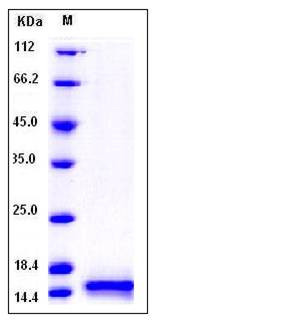Human Cystatin B / CSTB Protein (His Tag)
CST6,EPM1,EPM1A,PME,STFB,ULD
- 100ug (NPP3788) Please inquiry
| Catalog Number | P10435-H07E |
|---|---|
| Organism Species | Human |
| Host | E. coli |
| Synonyms | CST6,EPM1,EPM1A,PME,STFB,ULD |
| Molecular Weight | The recombinant human CSTB consisting of 108 amino acids and has a calculated molecular mass of 12.5 kDa. It migrates as an approximately 15 kDa band in SDS-PAGE under reducing conditions. |
| predicted N | Met |
| SDS-PAGE |  |
| Purity | > 95 % as determined by SDS-PAGE |
| Protein Construction | A DNA sequence encoding the human CSTB (P04080) (Met 2-Phe 98) was expressed, with a polyhistide tag at the N-terminus. |
| Bio-activity | Measured by its ability to inhibit papain cleavage of a fluorogenic peptide substrate Z-FR-AMC (R&D Systems, Catalog # ES009). The IC50 value is < 15 nM. |
| Research Area | Cardiovascular |Atherosclerosis |Thrombosis |Other in Thrombosis |
| Formulation | Lyophilized from sterile 50mM Tris, 50mM NaCl, pH 8.0 1. Normally 5 % - 8 % trehalose, mannitol and 0.01% Tween80 are added as protectants before lyophilization. Specific concentrations are included in the hardcopy of COA. |
| Background | Cystatin-B, also known as CPI-B, Liver thiol proteinase inhibitor, Stefin-B, CSTB and CST6, is a cytoplasm and nucleus protein which belongs to the cystatin family. Cystatin-B / CSTB is an intracellular thiol proteinase inhibitor. Tightly binding reversible inhibitor of cathepsins L, H and B. Cystatin-B / CSTB is able to form a dimer stabilized by noncovalent forces, inhibiting papain and cathepsins l, h and b. Cystatin-B / CSTB is also thought to play a role in protecting against the proteases leaking from lysosomes. Defects in Cystatin-B / CSTB are the cause of progressive myoclonic epilepsy type 1 (EPM1) which is an autosomal recessive disorder characterized by severe, stimulus-sensitive myoclonus and tonic-clonic seizures. The cystatins are a family of cysteine protease inhibitors with homology to chicken cystatin. Cystatins are physiological inhibitors of cysteine proteinases which are widely distributed in human tissues and fluids. Cystatins typically comprise about 115 amino acids, are largely acidic, contain four conserved cysteine residues known to form two disulfide bonds. Cystatins may be glycosylated and / or phosphorylated, with similarity to fetuins, kininogens, stefins, histidine-rich glycoproteins and cystatin-related proteins. Some of the members are active cysteine protease inhibitors, while others have lost or perhaps never acquired inhibitory activity. Cystatins mainly inhibit peptidases belonging to peptidase families C1 (papain family) and C13 (legumain family). |
| Reference |
